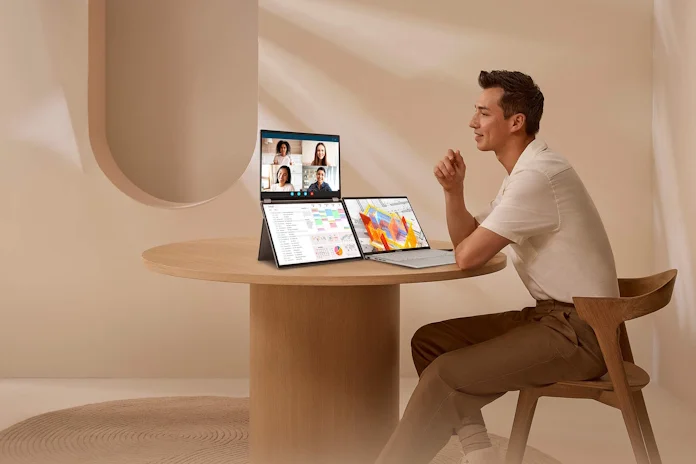Starting with the pandemic, the 2020s saw a massive acceleration in the trend toward mobility in business. With remote work here to stay and business travel back in action, portable computing has become the norm. It makes sense for today’s business leaders to rethink the technology they provide to knowledge workers. Since laptops replaced desktops as standard-issue computers, the time has come for companies to boost employee productivity by providing a portable monitor for laptops. When you make a portable monitor standard-issue for each laptop, you streamline your employees’ workflows and make multitasking easier. The result is fewer distractions, which helps employees increase productivity and minimize down-time.
Workers on the go need mobile monitors
Let’s face it: the story of today’s work is no longer about a dedicated workplace desk or a big home office. It’s all about what workers can get done on the go, whether they’re working part of the week from home, combining business trips with pleasure travel, or just spending some time in the field. A powerful, rugged laptop makes work possible under all these conditions and more. But giving up the desktop PC doesn’t have to mean giving up the advantages of a well-supplied workspace, especially the multi-monitor setup favored by many workers who depend on multitasking.
By far, the biggest advantage from getting a portable monitor for laptops is the time saved. The second screen helps workers recapture hours of productivity per week. These savings come from running multiple programs at once on multiple screens, which keeps every program window in full view. An active project occupies one window with supporting documents populated around it, which minimizes head-turning, neck strain, and unnecessary keystrokes to tab between windows.
Even better, the instant a worker needs help with their project, they can easily call upon your company’s AI tools. By keeping an open window visible with an AI chatbot side-by-side with a project, workers have immediate assistance without task switching. Glancing rapidly between windows helps employees integrate the AI into their workflow quickly, no matter where they are.
As the multi-monitor setup makes task switching easier, you can expect to see some gains in productivity. Research suggests that reducing the burden of task switching helps workers recover lost time. Think about messaging applications alone. By one estimate, a typical worker receives an average of 96 incoming messages through email, Slack, and Microsoft Teams during a given workday. These messages roll in while the worker is trying to make progress on a major project or meet a looming deadline.
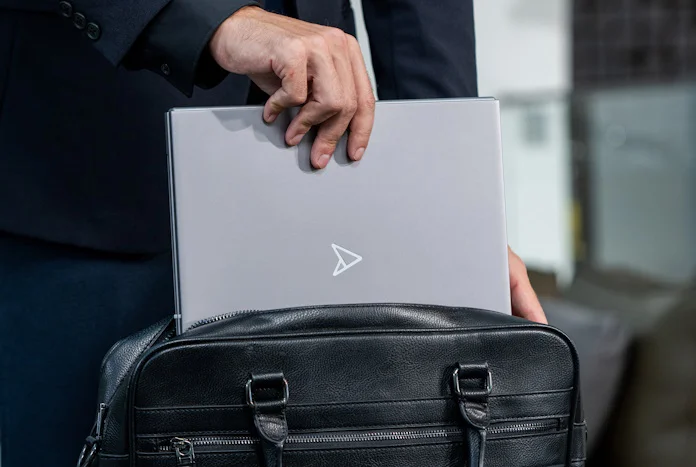
But each message-notification pulls the worker’s focus away from their primary task, requiring a few seconds to scan and respond to the message. On average, it takes 64 seconds to refocus and resume work after each interruption, translating to ninety minutes per day in lost productivity. With a portable monitor for their laptop, workers can dedicate a corner of one screen to their messaging apps. When a message comes in, it’s easy to rapidly glance at the message and triage it. If it doesn’t require immediate attention, they can get back to work without missing a beat.
How to pick up a portable monitor and laptop that work well together
When you pair a portable monitor with your laptop, the correct connectivity is key. To make setting up a mobile workspace as easy as possible, you want a laptop that uses a single port for two different purposes: first to power the portable monitor, second to send the display signal. On the laptop, look for a USB Type-C port that offers both USB PD and DP Alt Mode. A USB-C port with that capability uses a single cable to switch on the portable monitor and expand the laptop’s visual range onto the second screen.
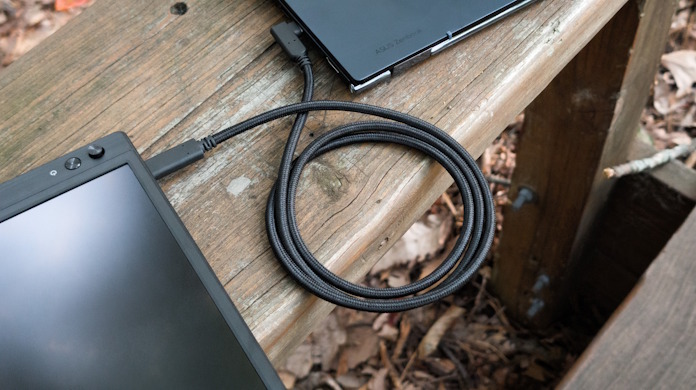
To keep things simple, issue your employees laptops that feature Thunderbolt 4 or Thunderbolt 5 ports. Both options provide both power and display outputs as standard issue. Thunderbolt 5 ports also give a significant boost to bandwidth, up to 120Gbps.
Besides connectivity, the second major consideration is size. Today’s portable monitors range from 14 inches at the lower end all the way up to 27 inches at the high end. For some users, it makes sense to match the size of the portable monitor to the screen size of their laptop. Such smaller portable monitors make for tidy workspaces and easy travel. Also, this setup puts both the screens of both the laptop and the portable display on the same level, which makes working between screens intuitive. Other users prioritize the size of their portable display. Extra-large screens give them more desktop real estate to work with, allowing more open windows and advanced multitasking.
A final consideration is the type of panel you want for your portable monitor. Some employees appreciate matching their portable display’s panel to the panel type of their laptop. This match keeps program windows running at the same resolution with the same image quality whenever the window is moved from one screen to another. Putting an OLED with an OLED, or an LCD with and LCD, will minimize distracting alterations to the image as windows jump between displays. Luckily, the ASUS range of portable monitors includes a size and panel type that is perfect for everyone on your team.
Hybrid work calls for versatile, portable tech
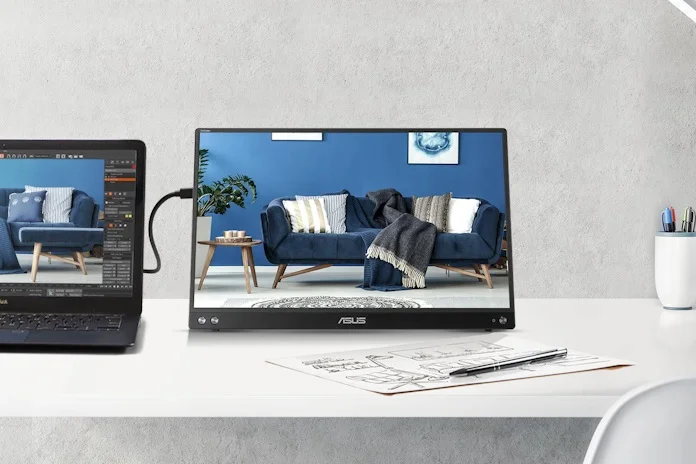 The most affordable choice in our ASUS lineup of portable monitors for laptops is the ZenScreen MB169CK. This 16-inch portable IPS display (15.6-inch viewable) features an ultraslim, thin design that makes it perfect for employees on the go. The TÜV Rheinland-certified flicker-free screen with low blue light technologies will let them keep eyes on their projects, leading to longer work sessions without eyestrain. And with a suggested retail price of just $109, the ZenScreen MB169CK will make a manageable impact on your capital expenditures budget.
The most affordable choice in our ASUS lineup of portable monitors for laptops is the ZenScreen MB169CK. This 16-inch portable IPS display (15.6-inch viewable) features an ultraslim, thin design that makes it perfect for employees on the go. The TÜV Rheinland-certified flicker-free screen with low blue light technologies will let them keep eyes on their projects, leading to longer work sessions without eyestrain. And with a suggested retail price of just $109, the ZenScreen MB169CK will make a manageable impact on your capital expenditures budget.
Equip your office with convenient, easy hot-desking with these movable monitors
More businesses than ever are optimizing their office space and reducing costs by letting employees share desk space. This strategy makes sense in a world where hybrid work is increasingly common. As desks become less private and more public within your organization, it makes sense to equip your office with monitors that can move around with the employee who needs them most.

But flexibility doesn’t have to come at the cost of quality or screen space. If you equip your office with the ASUS ZenScreen MB249C portable monitor, you’ll be giving all your hot-desking employees a second screen they can really work with. This ZenScreen’s frameless IPS display gives 23.8 inches of viewable desktop real estate in a sleek, ultraslim profile weighing just over six pounds. Its light-weight, slim profile and integrated carrying handle make moving the MB249C to a new desk effortless. For rapid setup, the carrying handle doubles as a kickstand. For maximum flexibility, the MB249C also includes a height-adjustable C-clamp with Z-axis adjustment, and a partition hook kit allows you to hang this ZenScreen from the wall of any cubicle.
For an even larger upgrade to your hot-desking employees’ multi-monitor setup, choose the ASUS ZenScreen MB27ACF. This transportable monitor’s gives you all the flexibility and setup options of its smaller cousin in a larger package, thanks to its multiple stand options and accessories. The generous 27-inch display provides a QHD (2560×1440) resolution, resulting in image quality sharp and detailed enough for even the most demanding visual projects. And a full lineup of connectivity options helps each employee quickly set up their workspace, including a full-function USB-C port with 70-watt power delivery, HDMI, and an audio combo jack.
Give creators the accurate, versatile tools they need
Nobody on your team knows better than creators how superior-quality tech leads to better projects. Visual designers need access to high-resolution displays even when they’re away from the design lab. Graphic artists need to see their work in the full range of colors with the sharpest contrast, brightest hues, and most accurate color rendering available. For employees like these, we recommend the ASUS ZenScreen OLED MQ16AHE portable monitor. The MQ16AHE comes with a 16-inch (15.6-inch viewable) Full HD OLED panel that gives creators 100% coverage of the cinema-grade DCI-P3 color gamut.
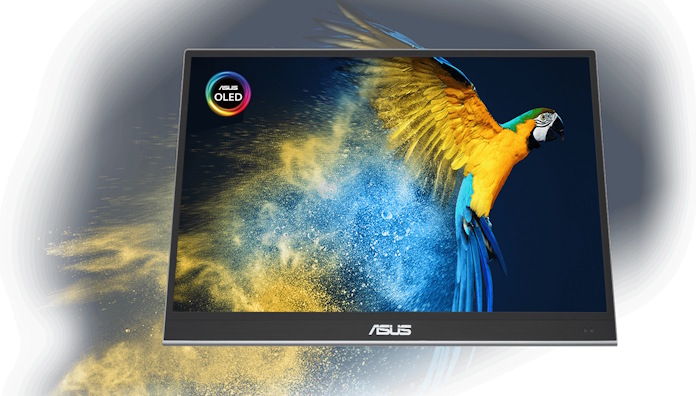
When your creative employees bring this portable monitor along with their creator-class laptop, they’ll have instant access to extreme blacks, significantly high perceptual brightness, and more color information than SDR alternatives. Whether creators need to catch up on their work out of the office, share their latest draft with a client, or just swap one work desk for another, they’ll have reliable access to a portable panel with picture quality that matches higher-end desktop displays.
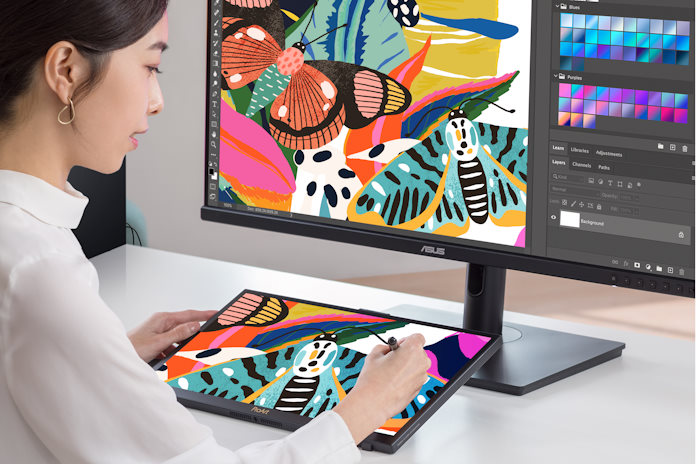
If you have more hands-on creators on staff, you could opt for the ProArt Display PA169CDV. This portable monitor’s 4K UHD (3840×2160) resolution doesn’t just deliver exceptional image quality. It also provides professional-grade color accuracy that is factory pre-calibrated to Delta E<2 and Calman Verified.
In addition to top-quality images, the ProArt Display PA169CDV gives creators maximum flexibility and responsiveness. Two kickstands prop the panel up at different angles to keep it handy and useful from one moment to the next. When the PA169CDV is perfectly positioned and the time is right for fine-tuning a project, this portable monitor provides 10-point touchscreen and stylus support. With support for WACOM EMR, the stylus behaves like a battery-free pen that writes and draws with paper-like precision. The screen even recognizes changes in the stylus’ tilt, position, and pressure. Notes can be recorded and quick edits can be made to a project on the fly, in the field, any time.
A third screen doesn’t require a third portable monitor
Getting into a really good workflow always seems easier with a multi-monitor setup. Once you’ve organized all your open windows so that everything is visible at a glance, it makes sense to start wishing for a third display. With the ASUS ZenScreen Duo OLED MQ149CD, you can have that third screen from the start.
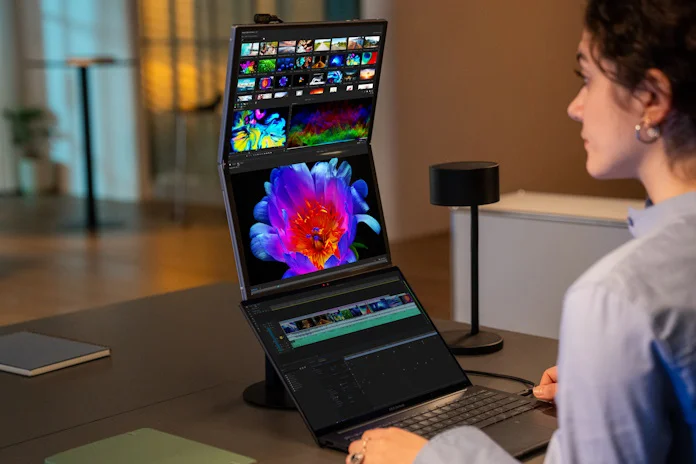 The two 14-inch OLED panels have an 1920×1200 resolution with a 16:10 aspect ratio. This combination of high resolution and wide aspect ratio lets your employees expand their workspace a full 20 inches. But having two panels doesn’t mean skimping on color quality. The ZenScreen Duo portable monitor gives laptop users a full 100% DCI-P3 color gamut coverage with Delta E<2 color accuracy.
The two 14-inch OLED panels have an 1920×1200 resolution with a 16:10 aspect ratio. This combination of high resolution and wide aspect ratio lets your employees expand their workspace a full 20 inches. But having two panels doesn’t mean skimping on color quality. The ZenScreen Duo portable monitor gives laptop users a full 100% DCI-P3 color gamut coverage with Delta E<2 color accuracy.
As always, the portability of these twin displays makes them endlessly versatile. The two panels are joined together with a durable hinge that folds a full 360 degrees°. An integrated fold-out kickstand supports the monitors in both portrait and landscape orientations. With this array of options, no matter what work environment your employees are faced with, they’ll set up a smooth workflow in no time.
The best portable monitors for laptop users
Since work has gone mobile, portable monitors for laptops are the natural next step. Multi-monitor setups lead to higher productivity and better organization, resulting in lower levels of stress. Businesses that adapt to this mobility will help employees stay efficient on the go, especially when they pair the right piece of tech to the right worker.
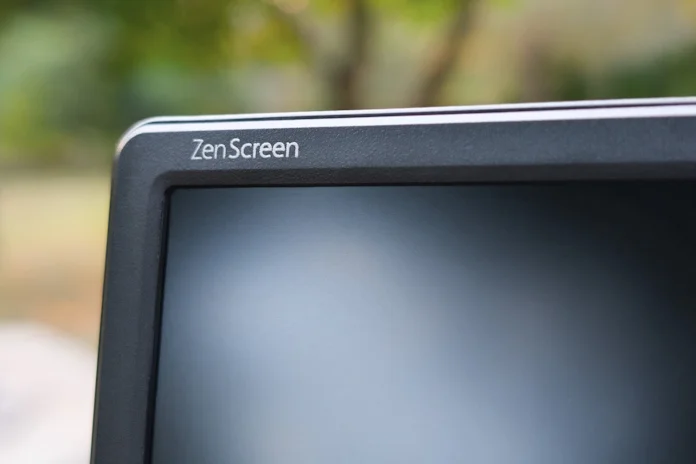
Within the full range of ASUS ZenScreen and ProArt Displays, you’ll find an option that is optimized for your company’s employees, technical requirements, and office layout. You can position a transportable monitor at a workstation to maintain its ergonomics and upgrade its flexibility. Or equip your mobile workers with portable monitors for their laptops to keep them productive, well organized, and calmy focused.

